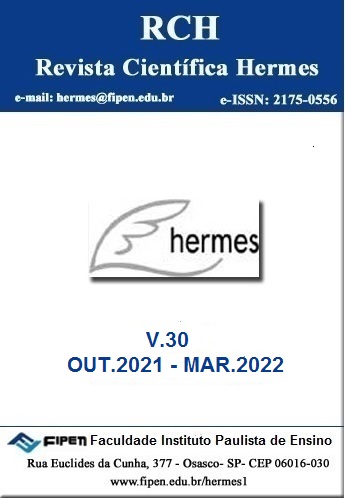Economia circular: estudo de caso na empresa ABC
DOI:
https://doi.org/10.21710/rch.v30i0.613Palavras-chave:
economia circular, sustentabilidade, lixo eletrônicoResumo
A economia circular (EC) é vista como um processo chave para promover a dissociação entre o elevado consumo de recursos e o crescimento econômico. Ela apresenta inúmeros benefícios, mas ainda há lacunas entre sua teoria e o processo de implementação. O presente artigo visa analisar e salientar as vantagens e benefícios da aplicação da economia circular, bem como identificar pontos importantes para enfrentar as barreiras e alcançar as oportunidades no setor de manufatura. A estratégia de pesquisa adotada foi a pesquisa exploratória realizada por meio de entrevistas, com pessoas da empresa, envolvidas no assunto em questão. O resultado encontrado mostrou que o desenvolvimento de parcerias é fundamental na economia circular. Na empresa pesquisada as parcerias, para otimizar a logística reversa, permitiram reduzir os custos do cliente em até 30% e elevar o tempo de coleta em 50%.
Referências
Campolina, J., Sigrist, C., De Paiva, J., Nunes, A.,& Moris, V. (2017). A study on the environmental aspects of WEEE plastic recycling in a Brazilian company. The International Journal of Life Cycle Assessment volume -Springer, 1957-1968.
COM -European Commission(2014). Towards a circular economy: a zero waste programme for Europe. Bruxelas.
Di Maio F., Rem C. P. A Robust Indicator for Promoting Circular Economy through Recycling. Journal of Environmental Protection,Vol.6 No.10, October 9, 2015.
Flex. Bringing circular manufacturing to electronics with Sinctronics.Recuperado de https://flex.com/resources/bringing-circular-manufacturing-to-electronics-with-sinctronics
Garcés, C., Rivera, P., Suárez, I.,& Dante I. La Hiz, L.(2019).Is it possible to change from a linear to a circular economy? An overview of opportunities and barriers for European small and medium-sized enterprise companies. International Journal of Environmental Research, 1-15. doi:10.3390/ijerph16050851
Geissdoerfer, M., Savaget, P., Bocken, N. M. P.,& Hultink, E.J. (2017). The circular economy: A new sustainability paradigma?Journal of Cleaner Production,143,757-768.
Gonçalves, M. T.,& Barroso, F. A.F. (2019). A engenharia de produção como meio de transformação social. XI SIMPROD Juiz de Fora, BH.
Govindan, K.,& Hasanagic, M. (2017). A systematic review on drivers, barriers, and practices towards circular economy: a supply chain perspective. International Journal of Production Research, 278-311. doi: 10.1080/00207543.2017.1402141
Gower, R.,& Schroeder, P. (2016). Virtuous circle: How the circular economy can save lives and create jobs in low and middle income contries. Tearfund and Institute of Development Studies.
Gregson, N., Crang, M., Fuller, S.,& Holmes, H. (2015). Interrogating the circular economy: the moral economy of resource recovery in the EU. 25. doi: 10.1080/03085147.2015.1013353
Hasanagic, M.,& Govindan, K. (2017). A systematic review on drivers, barriers, and practices towards circulareconomy: a supply chain perspective. International Journal of Production Research, 278-311. doi: 10.1080/00207543.2017.1402141
Kirchherr, J., Kris Hartley, Roosendaal, J. (2021). Barriers to the circular economy: The case of the Dutch technical and interior textiles industries. Journal of Industrial Ecology,1–14. doi/10.1111/jiec.13196
Kumar, V., Sezersan, I., Garza-Reyes, J. A., Gonzalez, E.,& Al-Shboul, M. A. (2019). Circular economy in the manufacturing sector: benefits, opportunities and barriers. Emerald Insight, 19. doi:10.1108/MD-09-2018-1070
Lakatos, E. M.,& Marconi, M. (2003). Fundamentos de metodologia científica. São Paulo: Atlas.
MacArthur. E. Foundation. (2014). Towards the Circular Economy, v.3. Cowes: Ellen MacArthur Foundation.
Preston L. Benjamin.(2002). Spatial Patterns in Benthic Biodiversity of Chesapeak Bay. USA: Association With Water Quality and Sediment Toxicit.
Sariatli, F. (2017). Linear economy versus circular economy: Comparative and analyzer study for optimization of economy for sustainability. Visegrad Journal on Bioeconomy and Sustainable Development, 1-34. doi:10.1515/vjbsd-2017-0005
Sauvé, S., Bernard, S.,& Sloan, P. (2016). Environmental sciences, sustainable development and circular economy: Alternative concepts for trans-disciplinary research. Environmental Development, 48-56.
Schroeder, P., Anggraeni, K.,& Weber, U. (2018). The relevance of circular economy practices to the sustainable development goals. Journal of Industrial Ecology, 1-19. doi:10.1111/jiec.12732
Tiossi, F. M., & Simon, A. T. (2017). A economia circular como ferramenta de apoio ao desenvolvimento sustentável.Anais do Fórum de Iniciação Científica do Unifunec,7(7). Recuperadodehttps://seer.unifunec.edu.br/ index.php/ forum/article/ view/2590
Van Buren, N., Demmers, M., Van Der Heijden, R., & Witlox, F. (2016). Towards a circular economy: The role of dutch logistics industries and governments. Sustainability, 17. doi:10.3390/su8070647
Winans, K., Kendall, A.,& Deng, H. (2017). The history and current applications of the circular economy concept. Elsevier, 825-833. doi:10.1016/j.rser.2016.09.123
Downloads
Publicado
Como Citar
Edição
Seção
Licença
Copyright (c) 2021 Délvio Venanzi, Orlando Roque da Silva, Amanda Seifert

Este trabalho está licenciado sob uma licença Creative Commons Attribution 4.0 International License.






